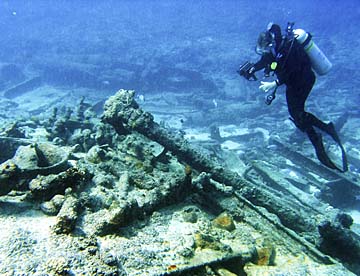
COURTESY NOAA NATIONAL MARINE SANCTUARY PROGRAM
A maritime archaeologist with the National Oceanic and Atmospheric Administration records details on one of three massive anchors at the Dunnottar Castle shipwreck site at Kure Atoll.
|
|
1886 shipwreck thrills scientists
Archaeologists peer through history's window at Kure Atoll
The loss of the sailing ship Dunnottar Castle in 1886 at Kure Atoll was blamed on a faulty timepiece.
Finding it again 120 years later on Hawaii's remotest piece of land was a stroke of luck, said Hans Van Tilburg, principal maritime archaeology investigator on a NOAA research cruise to the Northwestern Hawaiian Islands this summer.
Van Tilburg related tales of the ship's loss yesterday after the National Oceanic and Atmospheric Administration posted news about the Dunnottar Castle's rediscovery on its Web site.
Malfunction of the Dunnottar Castle's clock threw off calculations of its location badly enough that the 258-foot ship hit the reef on July 15, 1886, before sailors realized they were off course, Van Tilburg said.
"When those guys ran aground, they spent hours tossing coal over side trying to lighten the ship," Van Tilburg said. The British iron-hulled, three-masted vessel was en route from Australia to California with a load of coal, he said.
"It was a difficult time," Van Tilburg said of the era of steel-masted sailing ships of the late 1800s. "These were big ships sailed with small crews."
Finding the Dunnottar Castle in July brought to 24 the number of confirmed shipwreck and plane crash sites in the Northwestern Hawaiian Islands, said Van Tilburg, maritime heritage coordinator for the Pacific Islands office of NOAA's National Marine Sanctuary Program.
Van Tilburg's team of six marine archaeology specialists was busy studying two other wrecks at Kure Atoll -- the USS Saginaw and the Parker, a New Bedford whaling ship -- when they were alerted to the Dunnottar Castle, he said.
Biologists who had been observing a dolphin pod radioed the shipwreck specialists. "Because of calm weather, they had been able to scoot across a shoal area of the atoll where normally you don't really go," Van Tilburg said.
About 25 feet underwater they thought they saw something.
It turned out to be the remains of the Dunnottar Castle, including sections of iron hull, iron frames, rigging, masts, a steam boiler, anchors, windlasses, winches, capstans, davits, steering gear, cargo hatches, bowsprit, ladders and more, Van Tilburg said, all cemented to the sea bottom by coralline algae.
"It's very similar to the Falls of Clyde, about the same size," Van Tilburg said, referring to a museum ship in Honolulu.
On Van Tilburg's third voyage to the Northwestern Hawaiian Islands last year, he discovered some small pieces of coal at Kure that he speculated might have come from the Dunnottar Castle.
"Surveying wreck sites in the Hawaiian archipelago reveals our historic ties to the sea," Van Tilburg said yesterday. "But more importantly, understanding these heritage sites is simply another way of appreciating ocean resources in general, moving towards a larger vision of ocean stewardship."
The rescue vessel sent from Honolulu to pick up the Dunnottar Castle's crew claimed Kure Atoll for the kingdom of Hawaii, Van Tilburg said.
Last June 15, President Bush declared the Northwestern Hawaiian Islands the country's first marine national monument.

